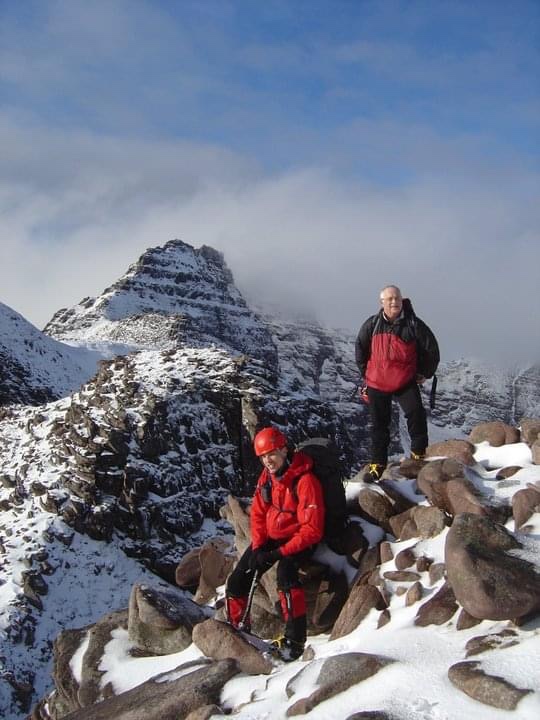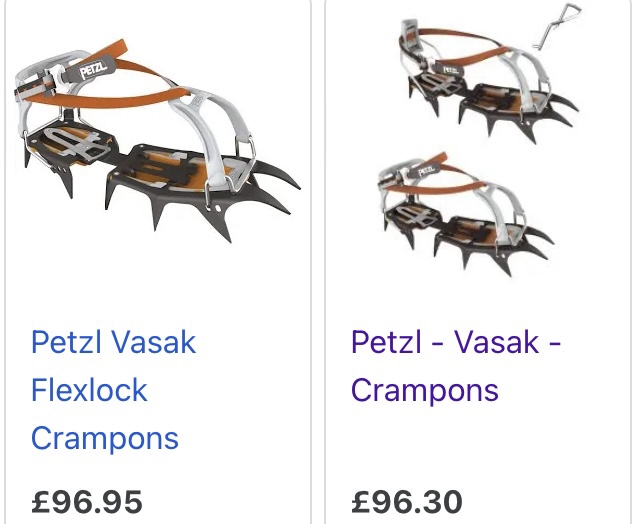My first time in crampons was in Feb 1972 it was on a remote Munro from Iron Lodge near Kintail. Mullach na Dheregain . I was with another team member from Kinloss he was supposed to be looking after me . He hardly spoke all day.
Just of the wagon we had to wear crampons early on the icy path then for most of the day. He never gave me any instruction or help. The Crampons were far to big for my “Curly boots” . In these days crampons were fitted to your boots by workshops who heated and bent them to fit. Many broke due to metal fatigue mostly on the hill. They were held together by huge straps that you were told not to cut to your boot size. In all most relied on cutting steps rather than the crampons. In a few months I bought my own boots and crampons and looked after them. They still took time to put on and off and many lessons were learned over the early years.


2022 – My crampons broke at the weekend at the heel. Top tip : I noticed when I got home and checked them out when I was drying them? There was a crack in the heel. I had them for over 10 years they are Grivels I am looking for some advice on what to purchase next.
I would like a strong but light crampon that fits on a solid winter boot. I only winter climb a couple of times a year now up to grade 3/4. Yet get out a fair bit in winter and use them a lot on mixed ground and even frozen grass.

Frozen grass can be deadly and rough on your crampons how many folk have used them on steep grass.

A few mates are advising the Petzl Vasak is one idea? Which model do you have ?

Crampons – It’s amazing how many carry crampons but rarely use them? Many think there is to much faffing when putting of and on. Yet I found that the more you do it the easier it becomes. That was proved this weekend as on the Saturday we took them off and on three times and each time the group got more proficient.

My trusty Grivels crampons seen years of abuse! I loved them though.

Top Til – It is worth practising putting crampons on in a non hostile environment. My dog was asleep after we helped this lad.

There have been so many improvements over the years and crampons are so easy to put on and off. Top tips: carry them in a crampon bag to save tearing your kit.

Salewa Adjustable Crampons- Scottish Mountain Heritage Collection.

Info “German mountaineer, Herman Huber, created the first commercially produced adjustable crampon, in conjunction with Salewa, in 1961/62. He wanted a pair of crampons that he could easily adjust to fit both his climbing and ski mountaineering boots. Prior to this, crampons needed to be adjusted by heating and bending in a blacksmith’s forge and there was no connection between the front points, which was rather un-nerving as the steeper ice faces began to be conquered.
Salewa were makers of leather goods – their name taken from Sattler und leder Waren (Saddler and Leather Goods), but were quick to see the commercial potential of the adjustable crampon so invested heavily in the metalwork side of things.
Blacks of Greenock and the Graham Tiso outdoor shop in Edinburgh were the first UK importers of the new Salewa adjustable crampon in the 1960’s.
The pair we have here in the collection belonged to Mick Tighe’s Mountain Guiding Company, Nevis Guides. Mick well remembers hours of crampon adjusting on the arrival of a new bunch of clients and mountain guides in the 1970’s were part time mechanics since the bar that joined front and back sections of the crampon was forever breaking – usually half way up a climb in the freezing cold.
You’ll find much earlier and later versions of crampons elsewhere in our collection, also the toolbox that was used to adjust and repair them in the 1980’s.”Scottish Mountain Heritage Collection.
Crampons – Donated by Mick Tighe
These incredible crampons were a nightmare to put together but great crampons – Chounaird Rigid.

Yvon Chouinard started climbing very young 13 when he was interested in falconry, this led to him to climbing. To save money, he decided to make his own climbing tools, teaching himself blacksmithing, and eventually started a business. In the late 1960s, Chouinard and business partner Tom Frost began studying ice climbing equipment, and re-invented the basic tools (crampons and ice axes) to perform on steeper ice. The Chouinard/ Frost ice was an incredible ice tool, then came the Zero the one that I enjoyed using. Many will remember the re assuring thud when an axe was placed in good ice or neve. I used them for many years and what a magic axe and hammer. We used them in a very early trip to Canada ice in 1984 – what a great trip, what a great tool for its time.
What crampons do you advise ? Comments welcome .

The Scottish Mountain Heritage Collection (SMHC) is a unique assortment of mountain memorabilia from Scotland and around the world, which has been cobbled together here on our website in what we hope is a legible and enjoyable format. The site is a living thing as we continue to update, improve and add new acquisitions. So, please take a tour around our virtual museum and let us know if you have any ideas, new information, or indeed any donations. http://www.smhc.co.uk

Comments – A Jeff – the Grivel 12s are a good all rounder. Petzl are well worth considering as well as they can be lighter and better fitting for some boots.
R. Bale – MIC For classic mountaineering, look no further than the VASAK crampons! With 12 points, they provide good stability and bite on terrain ranging from glaciers to snow couloirs. They’re available in two different binding systems to adapt to different boot types, with or without toe and heel welts.

Brent – I have a few pairs for different purposes and different boots C1, C2 & C3. I haven’t climbed for a while so unless I am wearing my stiff winter boots I tend to take my C1 Kahtool crampons when I am out. Over many years I have found a invaluable, they have baskets for the toe area and strap on to the rear a little like old style crampons. They have a flexible bar and will fit all types of boots. Not particularly recommended but I have worn them on lightweight 2 season boots. They are best for general walking but I have used them in gullies and on steeper ridges when the occasion arose. I highly recommend them, just bought Dianne Watters-Craig a pair.
Adele – The only thing I would add here as non crampon expert, is that when I bought my Grivel G12s they came with two sets of the adjustable middle bar things – a very strong hard one, and a more flexi one. I really like being able to use the slightly more flexible one with my boots that are between B1 and B2, and then the stiff one with my proper B2s.
Maybe not associated with this post David but I have an urge to query you. Maybe you could highlight this on a future post. I shared a post to my old town of Stewarton’s facebook group it was from a SMR film of 3 climbers recently being walked off Beinn a chroin in a blizzard which had been forecast for days in advance. Storm Eunice. Since the beginning of lockdown I think MRT callouts rose by over 40%. I was seeing many people asking for advice on going on to the hills E.G. “ I was thinking of doing the Cobbler at the weekend. I have never done any hillwalking before but have seen pictures folk have posted recently. I see there is a path. I cant read maps but have an app on my phone and was wondering if anyone knows if the path is easily followed”. Or words to that effect. Sometimes I felt I had to tell folk not to go as they were maybe not ready for the undertaking. Or to join a club or go with experienced people. Just out of concern more than anything. Some of, in fact most of the replies I got criticised hill goers calling them everything from idiots to cretins. As a matter of satire I looked up the meaning of cretin – a person with cretinism, a foolish person, then I googled some MRT records. I looked at the list of professions of people rescued (this was around 1997 incidentally). Doctors, lawyers, dentists, civil engineers, 2 army lieutenants and the biggest of all teachers. An impressive array of foolish people. Also 2 sheep and Ed Stewart on a radio 1 roadshow. My point is the criticism of people who enjoy the mountains. On the golf course there is an annual tally of 999 calls for between 500-600 heart attacks annually. It was always my thought that the only people who should criticise those rescued are those who rescue???? I was at a lecture years ago by Mick Tigh, and he spoke of how he rescued 2 guys on Tower Ridge at the top of the Doulas boulder, winter conditions, no crampons or ice axes. He was at crossed swords as whether to boot there arses off The Ben for being as stupid or congratulate them for getting thus far with no gear. What is your coping mechanism for people, the press in particular who add so much spin and sensationalise affairs causing so much vitriol toward us mountaineers.
LikeLiked by 1 person
I wrote a piece on this for UKC
Mountain Accidents and Media Sensationalism – An Expert’s View
LikeLike
Is there a link.
LikeLike
Just Google UKC
LikeLike
Thank you
LikeLike